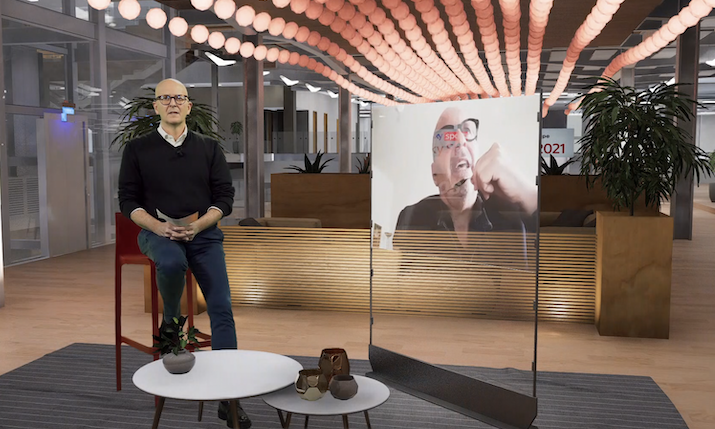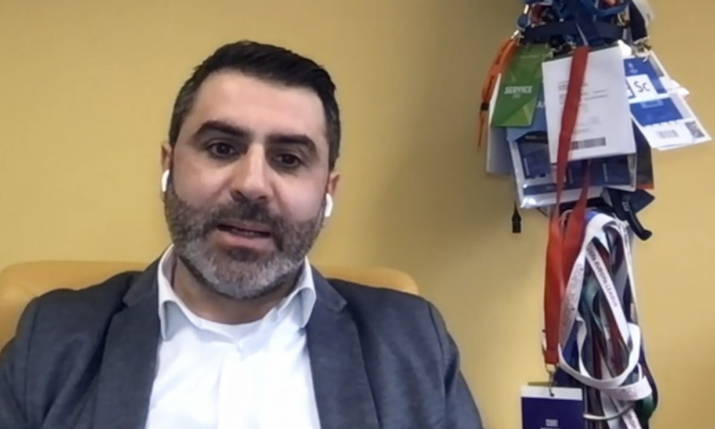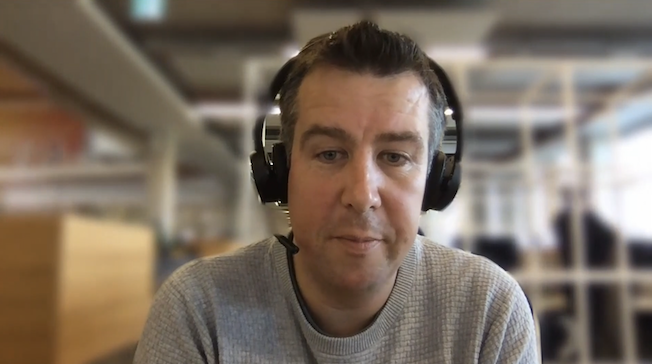Sky Sport Summit Italy – Part 1: 4K and remote production in the spotlight

Luciano Consigli chaired the session ‘Remote and Distributed Operations: What we learnt from COVID’
The Sky Sport Summit Italy 2021, in collaboration with SVG Europe, returned as a virtual event on 23 November hosted from a virtual studio in Milan. In the first of a two-part review, we look at some of the topics covered by those in attendance, including 4K in production and remote and distributed operations.
The event, introduced by Riccardo Botta, group director for content experience and distribution (CXD) operations at Sky, opened with a welcome from Alessandro Reitano, senior vice president sports production at Sky and SVG Europe’s advisory board chair, before Dante De Iulio, sport production and channel management director at Sky Italia, moderated a lively discussion on 4K.
Ivan Pintabona, CTO at NVP, highlighted that when it comes to 4K choices are driven by budget and user perception. “4K will become an obligation rather than a choice,” he said. “Conceptually we are ready, investments make the difference. The maximum achievable level exceeds 4K with native HDR, a type of shooting that greatly satisfies our eyes in terms of colour and contrast. Innovating the product is the next effort.”

Pintabona: ‘4K will become an obligation rather than a choice’
Andrea Buonomo, technical director and executive sales manager at Cinevideo, discussed the company’s role in the first Lega Serie B match to be shot and broadcast in 4K, and described the advances that have enabled this. “Today everything is much simpler and we work with HD on all productions,” he explained. “4K has been the standard on major events for at least six months and allows great visibility of the Italian product across Europe. The next step is HDR which allows for significant differentiation from competitors.”
Pintabona added that quality is key, and pilot events like the Olympics have shown that 4K can be done on top-of-the-line productions, even with 50 HDR cameras. “Settling on lower standards is shortsighted. There is no doubt that the way forward is quality and the enrichment of content,” he added.
In the second session, ‘Remote and Distributed Operations: What we learnt from COVID’, chaired by Luciano Consigli, content senior architect PB&C at Sky Italia, Reitano described industry reactions to the COVID crisis and the current fourth wave, calling it “a shocking moment for our industry”.
The panel discussed measures that have been taken to ensure broadcasting and personnel safety while also keeping fans engaged when they couldn’t be in the stadium.
Kevin McCue, director of group production platforms at Sky, said: “In the UK, the challenges of the pandemic have upset the sports and news sector. One of the main questions was how to accelerate remote mass production, especially in football. The English Football League (EFL) had already started with this in 2018, and they launched a project to produce totally remotely in 2019, so they have extended what they had already done. Upon returning to sports production in June, the focus was on how to get everything back together and it was decided to reuse the infrastructure that was already in place to produce up to 90% remotely.
“In a scenario similar to that of other broadcasters, they did have to rethink operations, such as how to enable people to work from home, and here innovation was fundamental.
“It was a monumental effort, adapting structures and technologies, but by handling huge volumes of content – 100 games in 40 days – it became clear that remote working is entirely plausible and will continue to accelerate. There is no impact on the quality of production; some ideas have been given new life thanks to remote production, which will be the new normal of our work.”
“It was a monumental effort, adapting structures and technologies, but by handling huge volumes of content – 100 games in 40 days – it became clear that remote working is entirely plausible and will continue to accelerate”
Aldo Napoleoni, head of engineering at Sky Italia, agreed that the pandemic accelerated the evolution of many processes, such as remote playout, editing and graphics, and the use of remote facilities.
“It was a change of mentality for the people and the structures,” he recalled. “The operations were previously very conservative, but they have dealt with the new normal with a lot of adaptation. All productions were done remotely, including TG (news) and guest shows, both editing and graphics. No one has noticed any difference and everyone has adapted to the new way of working.”

McCue: ‘The challenges of the pandemic have upset the sports and news sector’
Asked by Consigli to identify the key technologies that have been deployed to deliver these new ways of working, McCue highlighted vMix live video production software.
“Many innovations were introduced into production, and very quickly,” he recalled. “Several were not in the roadmap, like vMix which is now key to this way of working; it opened up the ability to manage people who operate on their devices, with commentary and contribution to programmes. vMix has facilitated the transition to remote working.”
Reitano added: “There is a lot of pressure on broadcasters which will increase due to the fragmentation of spectators. It is imperative to understand how technology can help and what it takes to take production to a higher level.
“All areas are affected, cloud, mix, automation and direction, to increase the level of audience engagement. There is a need to become stronger and it is the perfect time to do it. The workflow must be implemented with new ways of working that will remain in the future, well beyond the live event.
“COVID accelerated this. There was no need to change the system before, but it pushed us to produce more content and now we have to think about how to attract new audiences with the help of technology.”
“There was no need to change the system before, but [COVID] pushed us to produce more content and now we have to think about how to attract new audiences with the help of technology”
COVID also forced Sky Italia to utilise technologies that were previously not considered up to par, such as Skype, or other solutions to create audio commentary stations for the interviewer at home, such as remote talkback apps connected to an on prem server, according to Napoleoni.
“In fact, a work environment has been created in which nothing is missing compared to the one present on site,” he said. “It is a new way of working; before it was a substitute, today it is an increase in the production capacities on which the broadcaster can count. Being able to rely on even remote comment solves various problems, such as a guest who cannot leave their home. Logistical problems and various other difficulties are overcome: now it is very easy to create guest interventions everywhere.
“We have to leverage production capabilities based on new means, while maintaining the identity of the branding and content. New systems must be used appropriately – they are a part of production capacities that will remain and will be used more and more.”
As Consigli said: “These are aspects that have forever changed the perspective of TV production.”
Finally, Reitano touched on the subject of 5G and how to use it to produce end-to-end programmes in the cloud. “Operators have not highlighted any issues and are not concerned if the backend is in the cloud or on-premises, so there is confidence in moving to the cloud for the many possibilities it brings. The question is, how can we – at a group level – leverage the cloud to address the other possibilities that will open up? We are identifying which productions, which values and who can help us in this adventure.”
Consigli concluded: “Producing more content in the cloud is the key.”
The Sky Sport Summit Italy 2021, in collaboration with SVG Europe, took place on 23 November.
